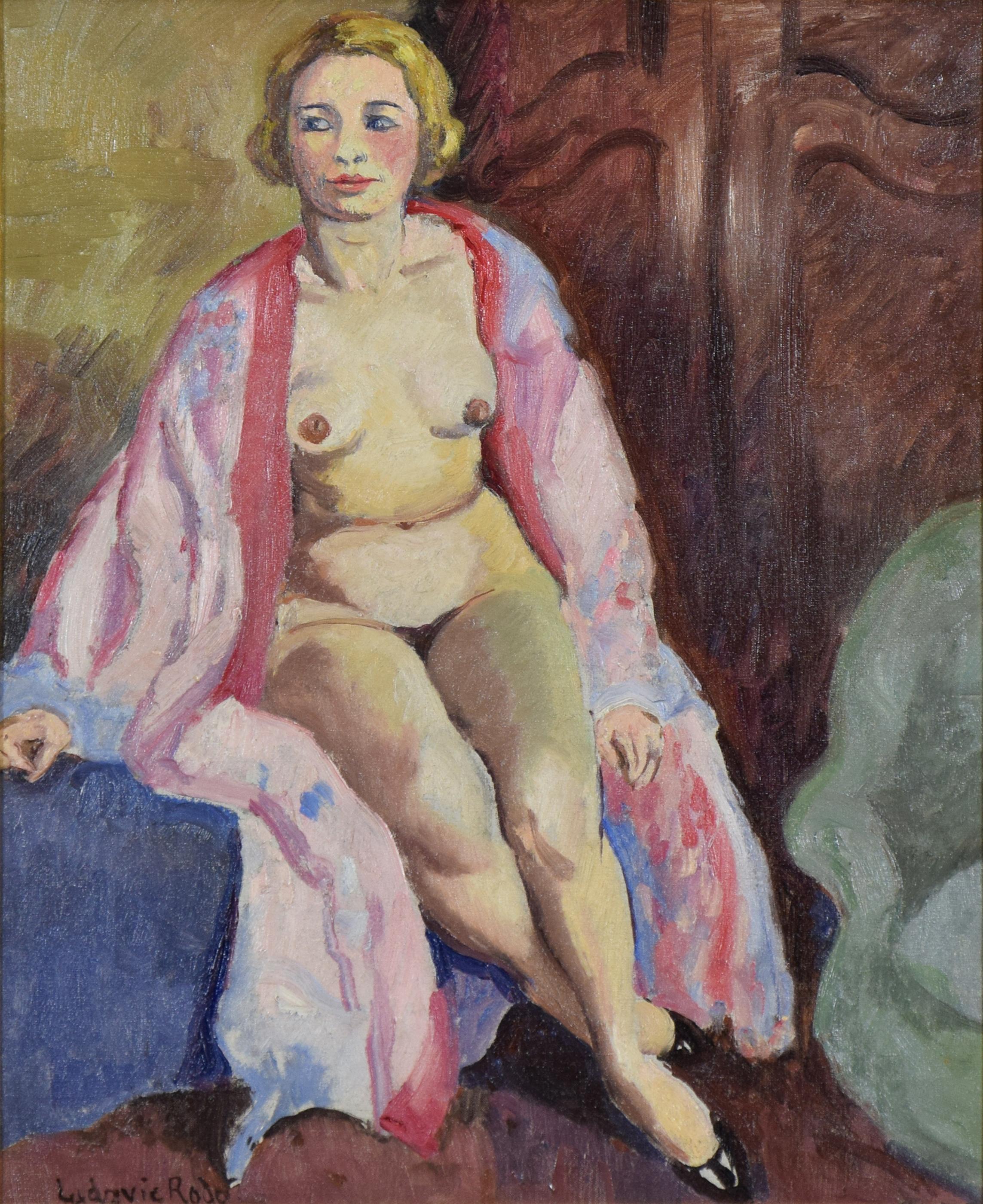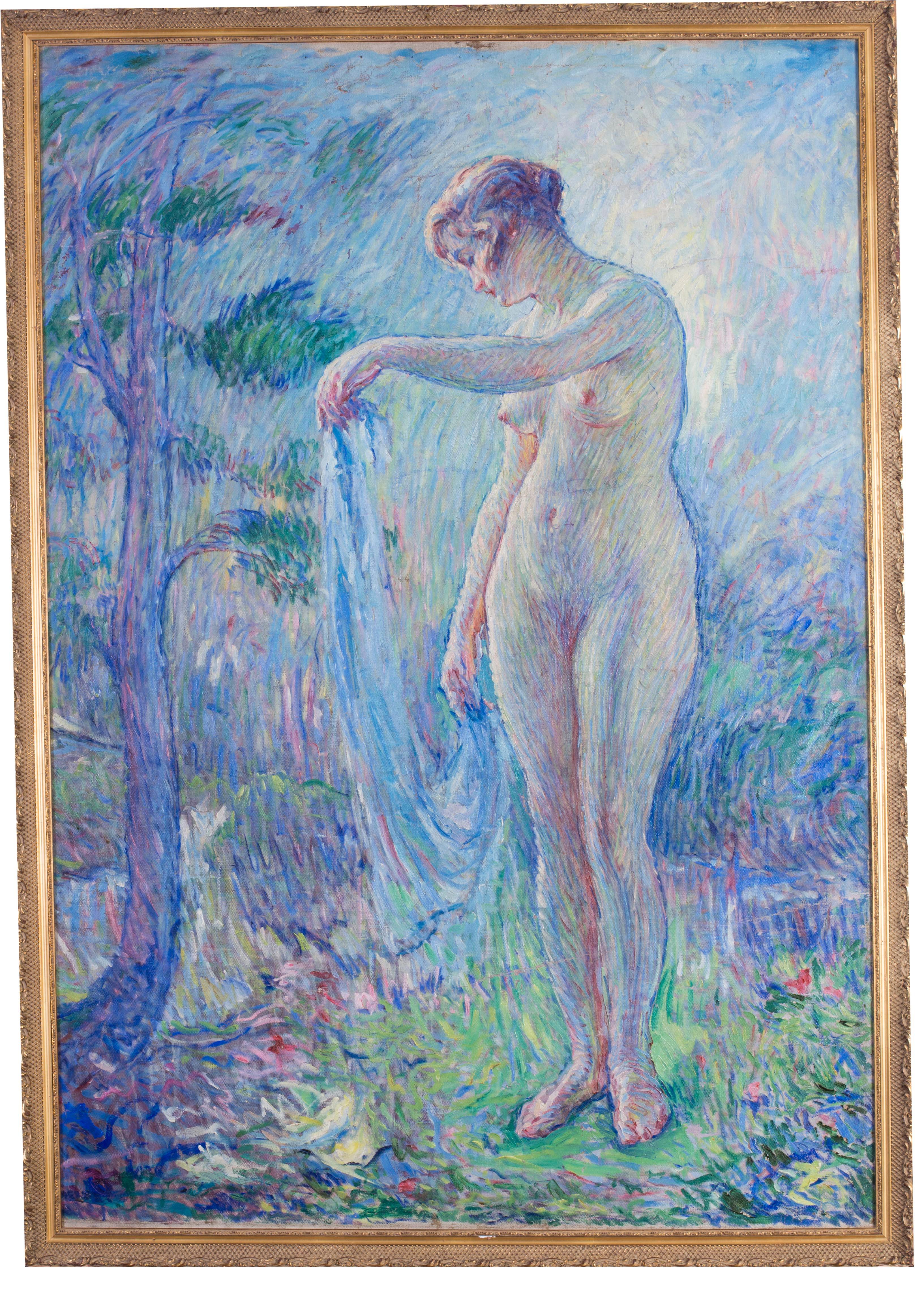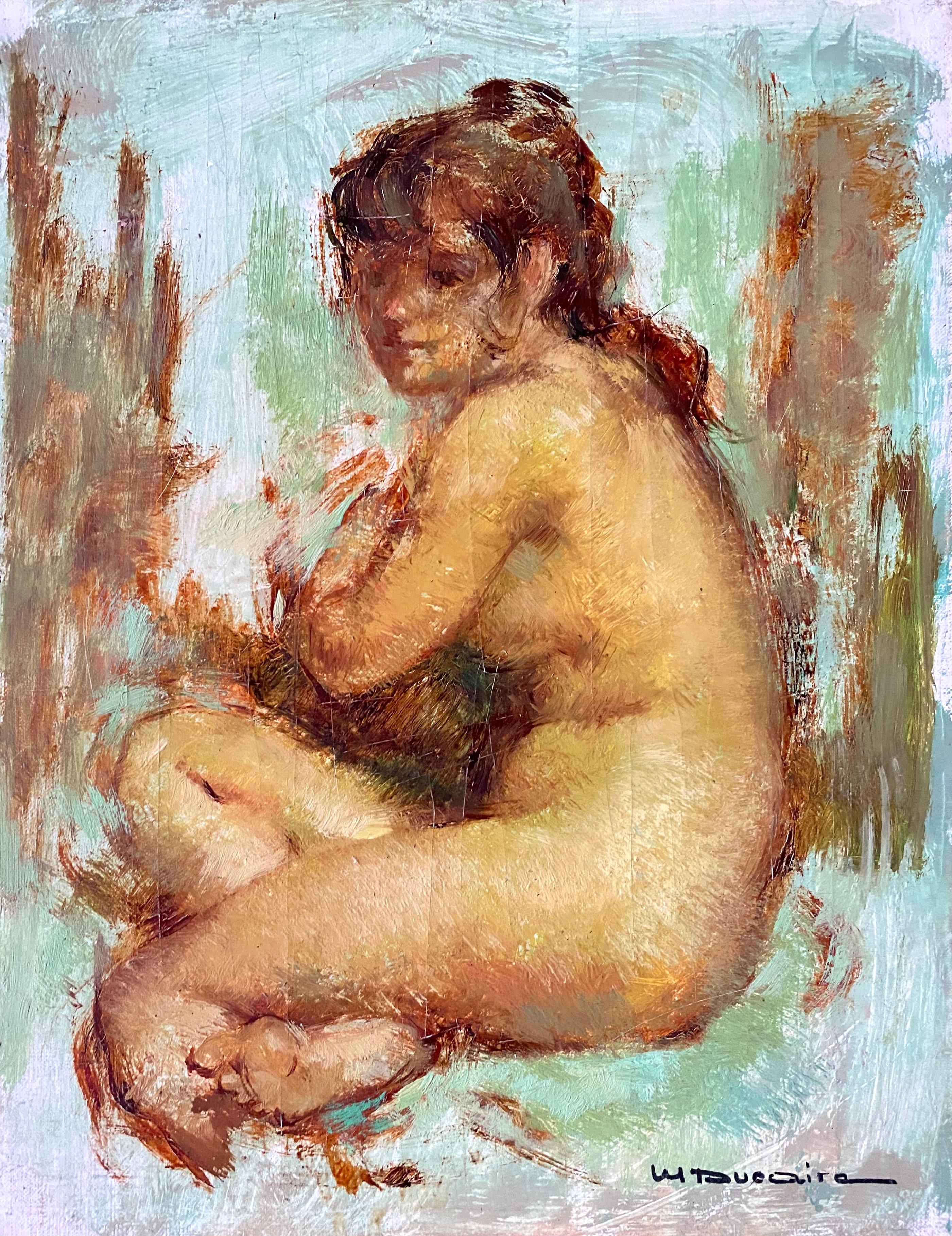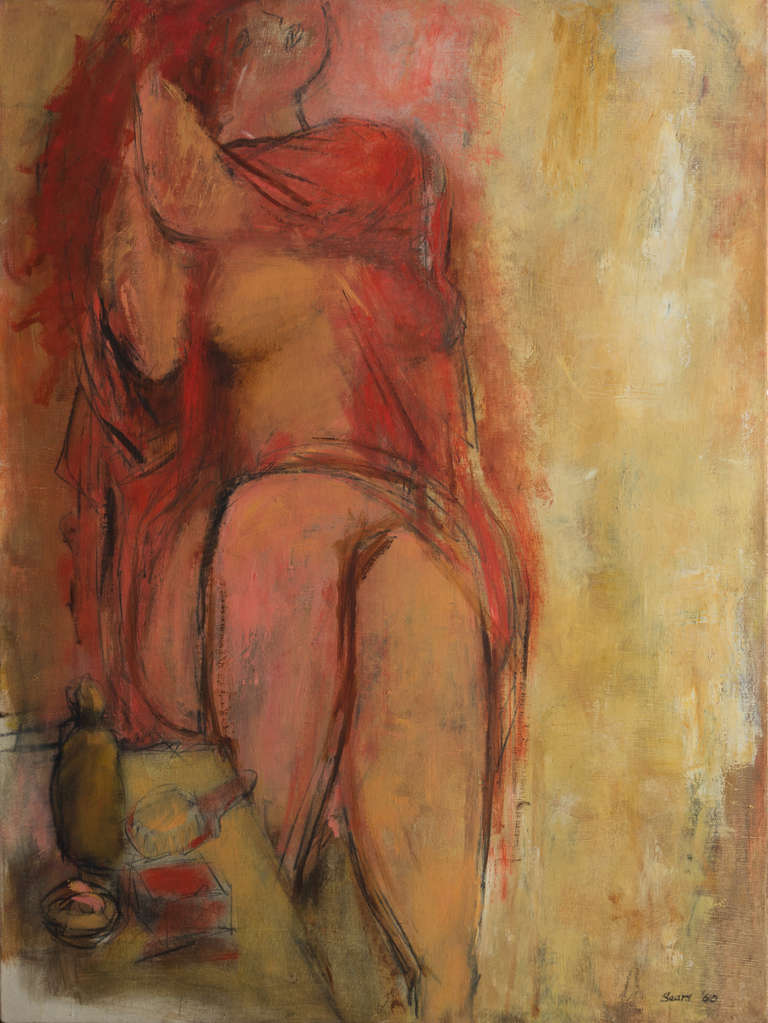Items Similar to 'Charlotte with Carnations', Paris, Royal Academy of Art, Denmark, Copenhagen
Want more images or videos?
Request additional images or videos from the seller
1 of 15
Evgenij Klenø'Charlotte with Carnations', Paris, Royal Academy of Art, Denmark, Copenhagen1977
1977
About the Item
Accompanied by 1979 exhibition label signed, 'Kleno' for Evgenij Klenø (Dutch, 1921-2005) and titled, verso, 'Charlotte'; additionally titled, verso, on stretcher bar 'Charlotte med Nelliken' (Charlotte with Carnations) and dated 1977.
This Russian-Danish Modernist painter and graphic artist studied under Bizzie Hoyer from 1941-1946 before attending the Kunstakademiet Copenhagen under Aksel Jorgensen, among others, from 1948-1958. Kleno has exhibited widely and with success.
Born in Denmark to a Russian mother, Kleno studied privately with Bizzie Hoyer from 1941-1946 and with Isaac Grünewald from 1943. He entered the Royal Academy of Fine Arts in 1948, where he studied under Axel Jorgensen and was also a pupil of Vilhelm Lundstrom and Olaf Rude. Kleno's works are known for their powerfully expressive attack, blending vivid tonal highlights with deep foundation colors. Kleno worked primarily with landscapes and still-lifes, but is also known for his portraits and nudes. He was inspired by fellow modernists such as Edvard Weie and Karl Isakson but quickly developed his own unique style which combined Expressionism and Fauvism with rapid, intuitive brushwork. From 1949, Kleno lived in Paris where he met and befriended the artists Robert Jacobsen, Richard Mortensen, Asgar Jorn and Serge Poliakoff. They lived together at a Danish artist's house and collaborated on several projects, holding numerous successful combined exhibitions at the Galerie Denise René. From 1952, Kleno also worked in Italy and, from 1955, In Spain. He later moved permanently to France, where he lived in the village of Bervardière in the Dordogne until his death in 2005. During his lifetime, Kleno was the recipient of numerous prizes, medals and juried awards including the prestigious Koefoed award (1961) and the Serdin Hansen Prize (1985). A book about the life and works of Kleno was published in 1998.
Exhibitions:
The Artists Fall Exhibition: 1947-1956.
Charlottenborg: 1966-1985.
Skive Museum of Fine Arts: 1974.
Aarhus Exhibition: 1978.
Gallery Trygve Petersen: 1963.
The Free Exhibition: 1965-1969.
Gallery Henning Larsen: 1983.
Rubin & Magnussen: 1985.
Taarnby Townhall: 1978.
Gallery Orbit: 1990
Reference:
Weilbach, Dansk Kunstnerleksikon; Davenport’s Art Reference Guide, 2007/8 Edition, p.1480; et al.
- Creator:Evgenij Klenø (1921 - 2005, Dutch)
- Creation Year:1977
- Dimensions:Height: 39.75 in (100.97 cm)Width: 35.5 in (90.17 cm)Depth: 0.75 in (1.91 cm)
- Medium:
- Movement & Style:
- Period:
- Condition:minor restoration, minor craquelure, minor losses; unframed.
- Gallery Location:Santa Cruz, CA
- Reference Number:1stDibs: LU3449005572
About the Seller
5.0
Platinum Seller
These expertly vetted sellers are 1stDibs' most experienced sellers and are rated highest by our customers.
Established in 1982
1stDibs seller since 2013
639 sales on 1stDibs
Typical response time: <1 hour
- ShippingRetrieving quote...Ships From: Santa Cruz, CA
- Return PolicyA return for this item may be initiated within 3 days of delivery.
More From This SellerView All
- 'Seated Nude', Paris, Louvre, Academie Chaumiere, Carmel, California, LACMA, OilBy Victor Di GesuLocated in Santa Cruz, CAStamped, verso, with the estate stamp for Victor Di Gesu (American, 1914-1988) and painted circa 1958. A substantial, Post-Impressionist style figural oil showing a young woman seat...Category
1960s Post-Impressionist Nude Paintings
MaterialsCanvas, Oil
- 'Nude in Ivory and Coral', Large Mid-Century Expressionist Figural OilBy Sears, Roebuck & CompanyLocated in Santa Cruz, CASigned lower right "Sears" (American, 20th century) and dated 1960. A substantial, Expressionist style figural oil showing a partially-draped woman seated at a dressing-table and br...Category
1960s Post-Impressionist Nude Paintings
MaterialsCanvas, Oil
- 'Seated Nude', Paris, Salon d'Automne, Royal Danish Academy, Expressionist OilLocated in Santa Cruz, CASigned lower right, 'Rob Leepin' for Robert Leepin (Danish, 1884-1967) and painted circa 1925. Robert Leepin first studied under Lauritz Tuxen and Viggo Johansen at Denmark's Royal ...Category
1920s Post-Impressionist Nude Paintings
MaterialsOil, Canvas
- 'Standing Nude', Royal Danish Academy of Fine Art, Copenhagen ModernistBy Evgenij KlenøLocated in Santa Cruz, CASigned lower left, "Kleno" for Evgenij Klenø (Dutch, 1921-2005). Oil nude showing a young woman standing with hands clasped below her chin and knees tur...Category
Late 20th Century Post-Impressionist Nude Paintings
MaterialsCanvas, Oil
- 'Figural Study, Rust & Jade', Paris, Grønningen, Danish National MuseumBy Helge JensenLocated in Santa Cruz, CASigned lower right, 'Helge' for Helge Jensen (Danish, 1899 - 1986) and painted circa 1925. This Danish Post-Impressionist first studied with Harald Giersing (1915-1916) before initi...Category
1920s Post-Impressionist Nude Paintings
MaterialsOil, Canvas
- 'Reclining Nude', San Francisco Woman Artist, Large Post-Impressionist OilLocated in Santa Cruz, CASigned lower right, 'Vivian R. Huebler' for Vivian Ruth Lewis Huebler (American, 1890-1975); additionally signed, verso, with artist address and painted circa 1955. Vivian Huebler w...Category
1950s Post-Impressionist Figurative Paintings
MaterialsCanvas, Oil
You May Also Like
- Nu Assise by Ludovic-Rodo Pissarro - Nude paintingBy Ludovic-Rodo PissarroLocated in London, GBNu Assise by Ludovic-Rodo Pissarro (1878-1952) Oil on canvas 55 x 47 cm (21 ⅝ x 18 ½ inches) Signed lower left, Ludovic Rodo Executed circa 1910 This work is accompanied by a cer...Category
1910s Fauvist Nude Paintings
MaterialsCanvas, Oil
- Large French Post Impressionist painting of a nude with blue tones by MalherbeBy William MalherbeLocated in Petworth, West SussexWilliam Malherbe (French, 1884 – 1955) La Baigneuse Oil on canvas 51 x 35.1/2 in. (130 x 90 cm.) William Malherbe was a French Post Impressionist painter born in 1884. His success c...Category
Early 20th Century Post-Impressionist Nude Paintings
MaterialsCanvas, Oil
- Orientala By Reuven RubinBy Reuven RubinLocated in New Orleans, LAReuven Rubin Israeli | 1893-1974 Orientala Signed “Reuven Rubin" Oil on canvas A striking and unique work rendered in a breathtaking jewel-toned palette, Orientala by Rueven Rubin...Category
20th Century Post-Impressionist Nude Paintings
MaterialsCanvas, Oil
- “Resting Female Nude”By Maryse Ducaire RoqueLocated in Southampton, NYBeautifully executed original oil on canvas painting by the French artist, Maryse Ducaire-Rogue of a seated female nude. Signed by the artist lower right. Condition is good. Circa ...Category
1970s Post-Impressionist Nude Paintings
MaterialsOil, Canvas
- Nu sur la plage - Post Impressionist Oil, Nude in Landscape by Henri LebasqueBy Henri LebasqueLocated in Marlow, BuckinghamshireSigned oil on canvas circa 1920 by French post impressionist painter Henri Lebasque. The work depicts a nude brunette woman lying on a beach, her arm draped over her head covering her face. A beautifully brushed piece. Signature: Signed lower left Dimensions: Framed: 22"x27" Unframed: 13"x18" Provenance: With thanks to Denise Bazetoux for confirming the authenticity of this work This painting is included in the Catalogue Raisonne of Henri Lebasque - Volume I No. 1409 Maitre Blache, Versailles, 21st November 1967 Lot 117 Maitre Lombrail, Enghien-les-Bains, 23rd September 1984 Sotheby's, London, 1st July 1987 Lot 317 Miromesnil Fine Art, Paris - 1988 Henri Lebasque studied at the École des Beaux-Arts in Angers, then, after moving to Paris in 1886, studied briefly under Bonnat, then under Humbert, whom he assisted in the decoration of the Panthéon. More importantly, he met and learned from Pissarro. In 1893 he met Luce and Signac at the Salon des Indépendants, and as a result he adopted Pointillism for a few years. In the 1900s he lived in Lagny with his family and painted landscapes of the neighbouring Marne forest. His painting underwent drastic changes when he discovered the south of the country. He would thereafter live in other French regions: Vendée, Brittany and Normandy, where he stayed at Les Andelys for some time, but his home from home was between Sanary and Nice. He painted members of his family in the settings in which he lived, mostly in Provence. His work shares some themes of his friend Bonnard. But although he exhibited with the Fauves, and admired Matisse, Rouault, Dufy, Valtat and Manguin (who introduced him to the Midi), he remained distinct from them in style. Lebasque was well known in his lifetime. He collaborated on the decorations of the Théâtre des Champs-Élysées and of the Atlantic liner Paris. He is remembered for: Nymphs at their Bath; The Sunshade; Girl with Hydrangeas; Great Nude on a Pink Sofa. He took part in the following collective exhibitions: Salon des Indépendants, 1886; Salon des Artistes Français; and later the Salon d'Automne, of which he was a founding member in 1903 and on whose committee he sat until his death. A set of his works was shown in 1937 at Masters of Independent Art ( Maîtres de l'Art Indépendant) at the Petit Palais. In 1957, 20 years after his death, a retrospective exhibition was held at the Musée des Ponchettes in Nice, and in 1981 his works were exhibited at St-Paul-de-Vence. Museum and Gallery Holdings Angers: The Artist's Mother Geneva (Petit Palais): The Child's Toilette (1900) Lille (MBA): Notre-Dame under Snow Nantes: Vallée de la Garde Paris (MAM): The Cigarette; Nude; Woman with NecklaceCategory
1920s Post-Impressionist Nude Paintings
MaterialsCanvas, Oil
- Le carnaval du sage by René MagritteBy René MagritteLocated in New Orleans, LARené Magritte 1898-1967 Belgian Le carnaval du sage (The Sage’s Carnival) Signed “Magritte” (lower right); titled and dated "Le carnaval du sage 1947" (en verso) Oil on canvas The enigmatic paintings of René Magritte have become some of the most familiar and celebrated of the Surrealist movement. Among the most influential of the Surrealist painters of the 20th century, Magritte is an artist of international renown, as beloved for his popular appeal as he is for the psychological intensity of his works. The present oil on canvas, entitled Le carnaval du sage, was executed in 1947 at the height of his career, and it is a tour-de-force example of the haunting, mysterious scenes that comprise his oeuvre. Painted in the years following the Second World War, Le carnaval du sage showcases several recurring themes from Magritte’s oeuvre. Chiefly, a juxtaposition between the visible and the hidden is keenly felt. Throughout his career, Magritte explores the psychological obsession with revealing what is hidden, particularly with regard to the human face. In his Le fils de l’homme, he obscures the face of a man in a bowler hat with an apple, while his Les amants (Metropolitan Museum of Art) conceals the faces of two lovers with white sheets. In Le carnaval du sage, Magritte juxtaposes the blatant nudity of his central figure by masking her face, simultaneously revealing and concealing her from the viewer. The work also incorporates two of Magritte’s most common tropes – the glass of water and the baguette. Lending the scene a strange sense of domesticity, they appear infinitely familiar and distinctly out of place, and thus heighten the uncanny effect of Magritte’s composition. In the background hovers a ghost obscured by a sheet, a figure which was of particular fascination to Magritte beginning in 1946. He once wrote to his fellow Surrealist Paul Nougé: "I saw in a dream an answer to the problem of the ghost: the traditional ghost draped...Category
20th Century Post-Impressionist Nude Paintings
MaterialsCanvas, Oil





